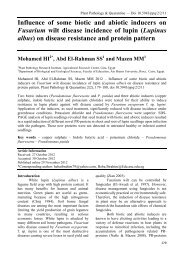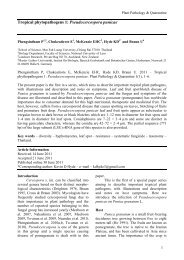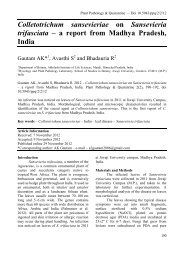Genus Cercospora in Thailand: Taxonomy and Phylogeny (with a ...
Genus Cercospora in Thailand: Taxonomy and Phylogeny (with a ...
Genus Cercospora in Thailand: Taxonomy and Phylogeny (with a ...
You also want an ePaper? Increase the reach of your titles
YUMPU automatically turns print PDFs into web optimized ePapers that Google loves.
etter workable system. Braun (1993) also<br />
established generic separation of <strong>Cercospora</strong><br />
on diverse criteria <strong>in</strong>clud<strong>in</strong>g ontogeny, pigmentation<br />
<strong>and</strong> ornamentation of conidia, conidiophores<br />
<strong>and</strong> conidiomata. Pons & Sutton (1988)<br />
described Distocercospora for <strong>Cercospora</strong>-like<br />
hyphomycetes <strong>with</strong> distoseptate, scolecosporous<br />
conidia. On the other h<strong>and</strong>, Braun (1993)<br />
separated Pseudocercospora-like species <strong>with</strong><br />
percurrently proliferat<strong>in</strong>g conidiogenous cells<br />
<strong>and</strong> Mycosphaerella teleomorphs from Stigm<strong>in</strong>a,<br />
<strong>and</strong> published the new genus Cercostigm<strong>in</strong>a<br />
U. Braun. Although Deighton (1967)<br />
separated Passalora <strong>and</strong> Cercosporidium on<br />
account of the presence or absence of a<br />
substomatal stroma, Braun (1995) redef<strong>in</strong>ed<br />
<strong>Cercospora</strong>, Passalora <strong>and</strong> Phaeoisariopsis.<br />
Braun (1995) discussed the status of these<br />
genera <strong>and</strong> noted that small stromata were also<br />
developed <strong>in</strong> the type species of Passalora.<br />
Therefore, the degree of the development of<br />
stroma-like hyphal aggregations <strong>in</strong> the substomatal<br />
cavities should not be used for generic<br />
differentiations <strong>with</strong><strong>in</strong> <strong>Cercospora</strong> <strong>and</strong> allied<br />
genera (Braun 1995).<br />
Crous & Braun (2003) re-exam<strong>in</strong>ed <strong>and</strong><br />
presented a compilation of more than 3,000<br />
names published <strong>in</strong> the genus <strong>Cercospora</strong> <strong>and</strong><br />
550 names <strong>in</strong> the genus Passalora. They<br />
separated the cercosporoid genera ma<strong>in</strong>ly based<br />
on a comb<strong>in</strong>ation of characters, of which the<br />
structure of conidiogenous loci (scars) <strong>and</strong> hila,<br />
the presence <strong>and</strong> absence of pigmentation <strong>in</strong><br />
conidiophores <strong>and</strong> conidia, <strong>and</strong> other characters<br />
described above (Crous & Braun 2003). A key<br />
to the true hyphomycetous cercosporoid fungi<br />
<strong>and</strong> related genera was also provided by Crous<br />
& Braun (2003). Based on these morphological<br />
categories, Crous & Braun (2003) retreated<br />
<strong>and</strong> re-exam<strong>in</strong>ed 5,720 names that<br />
related to <strong>Cercospora</strong> s. str. (sensu stricto), <strong>and</strong><br />
proposed 455 taxonomic novelties <strong>with</strong><strong>in</strong> 10<br />
genera <strong>in</strong>clud<strong>in</strong>g <strong>Cercospora</strong>, Dactylaria Sacc.,<br />
Fusicladium, Mycosphaerella (teleomorph),<br />
Passalora, Scolecostigm<strong>in</strong>a U. Braun, Semipseudocercospora<br />
J.M. Yen, Sirosporium,<br />
Sporidesmium L<strong>in</strong>k <strong>and</strong> Stenella Syd. Crous &<br />
Braun (2003) recognized only 659 names <strong>in</strong> the<br />
genus <strong>Cercospora</strong> <strong>with</strong> a further 281 be<strong>in</strong>g<br />
referred to C. apii s. lat. They also stated the<br />
need of a “compound species”, a species that is<br />
formed when two or more species jo<strong>in</strong> together<br />
Plant Pathology & Quarant<strong>in</strong>e<br />
because of <strong>in</strong>dist<strong>in</strong>guishable morphologically/genetically/physiologically,<br />
named C. apii s.<br />
lat. compris<strong>in</strong>g all cercosporoid hyphomycetes<br />
<strong>in</strong>dist<strong>in</strong>guishable from the <strong>Cercospora</strong> on<br />
Apium graveolens L. Introduction of new<br />
names for morphologically <strong>in</strong>dist<strong>in</strong>guishable<br />
<strong>Cercospora</strong> collections detected on new host<br />
genera <strong>and</strong> families, should be avoided, <strong>and</strong><br />
should simply be referred to C. apii s. lat.<br />
(Crous & Braun 2003).<br />
In <strong>Thail<strong>and</strong></strong>, there have been only a few<br />
reports of cercosporoid fungi. These <strong>in</strong>clude<br />
Sontirat et al. (1980) who enumerated 21<br />
species of <strong>Cercospora</strong>; a list of 47 identified<br />
<strong>and</strong> 13 unidentified species of <strong>Cercospora</strong> <strong>in</strong><br />
The Host Index of Plant Diseases <strong>in</strong> <strong>Thail<strong>and</strong></strong>;<br />
by Giatgong (1980); <strong>and</strong> a report on 49 species<br />
by Petcharat & Kanjanamaneesathian (1989).<br />
These reports were based on the generic<br />
concept <strong>in</strong>troduced by Chupp (1954). Further<br />
additional records of cercosporoid fungi <strong>in</strong><br />
<strong>Thail<strong>and</strong></strong> were also published by Ellis (1976),<br />
Manoch et al. (1986), Pons & Sutton (1988),<br />
Barreto & Evans (1994), Crous (1998), Crous<br />
& Braun (2003), Lumyong et al. (2003), Braun<br />
et al. (2006) <strong>and</strong> Hunter et al. (2006). As of this<br />
group of fungi <strong>in</strong> <strong>Thail<strong>and</strong></strong> is little known, the<br />
<strong>in</strong>formation is scattered <strong>and</strong> based on Chupp’s<br />
generic concept, a survey on diversity based on<br />
more recent taxonomic concepts <strong>in</strong>troduced by<br />
Deighton (1967, 1971, 1973, 1974, 1976, 1979,<br />
1983, 1987), Pons & Sutton (1988), Braun<br />
(1988a,b, 1989, 1990, 1993, 1994, 1995, 1996,<br />
1998, 1999), Crous & Braun (2003) <strong>and</strong> Crous<br />
et al. (2001, 2006, 2007) is for this group of<br />
fungi <strong>in</strong> this region.<br />
Morphology Characteristics<br />
Deighton (1967, 1971, 1973, 1974, 1976,<br />
1979, 1983), Pons & Sutton (1988), Braun<br />
(1993), Braun & Melnik (1997) <strong>and</strong> other<br />
authors divided <strong>Cercospora</strong> s. lat. <strong>in</strong>to numerous<br />
smaller genera based on morphological<br />
characteristics. Later, a comb<strong>in</strong>ation of morphology<br />
<strong>and</strong> molecular analysis were also<br />
carried out by Crous et al. (2000, 2001). From<br />
their <strong>in</strong>tensive research on this group of fungi,<br />
Crous & Braun (2003) published the compilation<br />
of the names <strong>in</strong> <strong>Cercospora</strong> <strong>and</strong> Passalora,<br />
<strong>and</strong> re-def<strong>in</strong>ed the morphological characteristics<br />
of <strong>Cercospora</strong> s. lat. based on morphology<br />
<strong>and</strong> molecular analysis. The follow<strong>in</strong>g<br />
13









